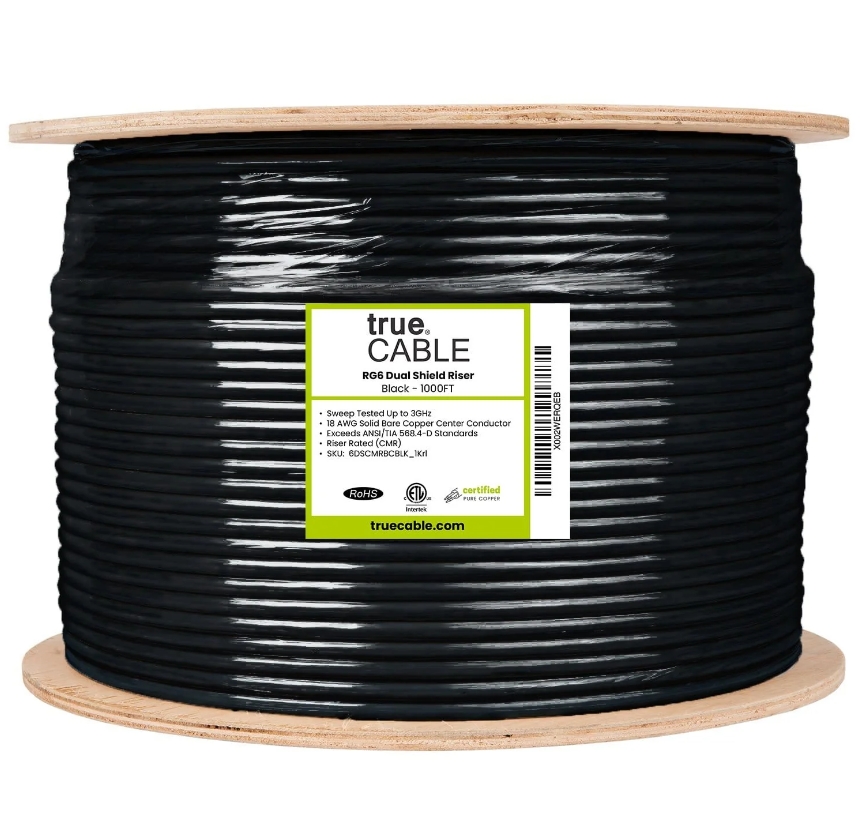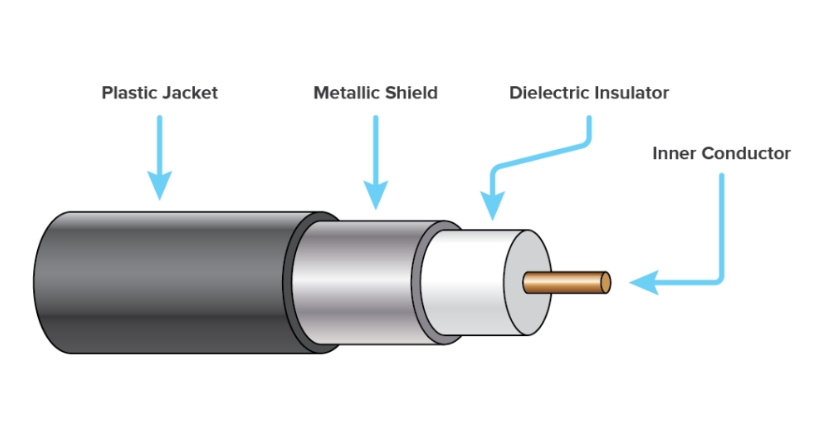What is the difference between RG6 and RG11 coaxial cables?

What is RG coaxial cable?

The uniqueness of this design is that it can effectively transmit analog and digital signals and is suitable for a variety of application scenarios. From the transmission of radio and television signals to long-distance telephone communications, to the connection of computer networks, coaxial cables play an indispensable role. Especially in cable television systems, coaxial cables have become an important bridge connecting thousands of households with their excellent signal transmission capabilities and stability. In addition, it also occupies an important position in the construction of local area networks, although the development of optical fiber communication technology in recent years has posed a certain challenge to its position.
How is coaxial cable constructed?
The construction of coaxial cable can be summarized into four main levels:
- Center conductor: The innermost layer is a solid or twisted copper wire for transmitting signals.
- Insulation layer: The center conductor is covered with a layer of insulating material, usually plastic, to isolate the conductor from contact with the outside world.
- Shielding layer: Outside the insulation layer is a shielding layer woven from metal wires, usually copper or copper alloy, to reduce electromagnetic interference.
- Outer sheath: The outermost layer is a tough plastic or rubber sheath that provides physical protection for the cable.
Such a construction ensures the stability and integrity of the signal during transmission, and also increases the durability of the cable.
Classification of coaxial cables
Coaxial cables can be divided into two categories according to their characteristic impedance and usage scenarios: baseband coaxial cables and broadband coaxial cables.- Baseband coaxial cables: This type of cable usually has a characteristic impedance of 50Ω and is suitable for transmitting high-speed digital signals. Common models include RG-8 and RG-58. RG-8 cable is suitable for building large network infrastructure due to its ruggedness, while RG-58 cable is lighter and more economical, suitable for small network environments.
- Broadband coaxial cable: This type of cable has a characteristic impedance of 75Ω and is mainly used to transmit analog signals, such as TV signals. Among them, RG-59 cable is very common in cable TV networks. It can not only transmit TV signals of multiple channels, but also be used in certain computer network applications.
RG6 coaxial cable Overview
RG6 coaxial cable, commonly known as "thin coaxial cable", has a characteristic impedance of 50 ohms. It has a variety of specifications, among which 75 ohm coaxial cable is the most popular choice. This cable is made of multiple strands or bundles of wires carefully twisted together, with each group of wires containing at least two strands. These wire groups are carefully insulated and arranged around the center conductor. The outer conductor uses a shielding mesh woven from multiple strands of copper wire to enhance the protection of the cable. This design balances the complexity and functionality of the cable while ensuring the quality of signal transmission.Structural parameters of RG6 coaxial cable
Center conductor:
- Material: Usually made of copper or silver-plated copper.
- Diameter: About 18 AWG (American Wire Gauge), which is about 1.02mm.
- Function: Used to transmit signal current.
Insulation layer:
- Material: Polyethylene (PE), cross-linked polyethylene (XLPE) or other low-loss materials.
- Thickness: Depends on the specific cable design, usually between 1.5mm and 2.5mm.
- Function: Isolate the center conductor to prevent current leakage and serve as a dielectric in the cable.
Shielding layer:
- First layer: Aluminum/Polyester Foil + Braided copper wire (Braid).
- Second layer: Braided copper wire (Braid).
- Function: Reduce electromagnetic interference (EMI) and radio frequency interference (RFI) and protect the signal from external interference.
Outer sheath:
- Material: Polyvinyl chloride (PVC) or polyolefin.
- Thickness: Usually between 1.5mm and 2.5mm.
- Function: Protects the internal structure from physical damage while providing waterproof and weather resistance.
Characteristic impedance:
- Value: 75Ω.
- Function: Ensures that the signal is not reflected during transmission, thereby maintaining the integrity and clarity of the signal.
Attenuation coefficient:
- Value: At 1GHz, it is approximately 6.1dB/100ft.
- Function: Measures the degree of energy loss when the signal is transmitted in the cable.
Bend radius:
- Minimum value: Usually 5 to 10 times the cable diameter.
- Function: Ensures that the internal structure is not damaged when bending the cable, thereby avoiding signal loss.
Temperature range:
- Operating temperature: Usually -40°C to +85°C.
- Function: Ensure that the cable can still work normally under extreme temperature conditions.
Outer diameter:
- Value: Usually 6.0mm to 7.0mm.
- Function: Determines the physical size and space occupancy of the cable.
Length:
- Range: Customized according to application requirements, ranging from a few meters to hundreds of meters.
- Function: Meet the wiring needs in different scenarios.
Working voltage:
- The maximum working voltage of RG6 cable is generally 3.0 KVrms (effective value), which means that it can be safely used under conditions that do not exceed this voltage.
Working temperature range:
- Depending on the jacket material, the working temperature range of RG6 cable will also vary. For example, the working temperature range of PVC-sheathed cables may be -25°C to +70°C, while PE-sheathed cables may reach -40°C to +80°C.
Application of RG6 Cable
RG6 cable is widely used in the field of video signal transmission due to its excellent performance. It can transmit high-definition video signals and is suitable for cable TV, satellite TV and HDTV systems in homes and commercial places. In addition, RG6 cable can also be used to connect surveillance cameras and other video devices to ensure high-quality video transmission.Steps to use RG6 cable
The process of transmitting video signals through RG6 cable is relatively simple and straightforward:
- Determine the transmission distance: First determine the distance you need to transmit the video signal to select the appropriate cable length.
- Connect the device: Connect the RG6 cable to the video device and display device (such as a TV) to ensure that the connection is correct and avoid signal interruption.
- Adjust signal strength: If the signal clarity is lower than expected, you can improve the transmission quality by adjusting the strength of the signal source or using a signal amplifier.
- Comprehensive test: After completing the above steps, perform a comprehensive signal test to ensure that the quality of video signal transmission meets the expected standards.
RG11 coaxial cable Overview
RG11 is a harder and thicker cable than other coaxial cables. Its attenuation characteristics are not significant within a distance of 100 feet, and the loss at 1000MHz is only 5.6dB. Therefore, RG11 cable is very suitable for signal transmission over longer distances, such as connections between telecommunication centers. Despite its excellent performance, RG11 cable is not suitable for indoor or home wiring due to its hardness and high cost.Structural parameters of RG11 coaxial cable
Center conductor:
- Material: copper or silver-plated copper.
- Diameter: usually 14 AWG (American Wire Gauge), which is about 1.62mm.
- Function: Transmit signal current.
Insulation layer:
- Material: polyethylene (PE), cross-linked polyethylene (XLPE) or foam polyethylene (Foam PE).
- Thickness: Thicker, usually between 3.0mm and 4.0mm.
- Function: Isolate the center conductor, prevent current leakage, and serve as a dielectric in the cable.
Shielding layer:
- First layer: Aluminum/Polyester Foil.
- Second layer: Braided copper wire (Braid), usually with a higher density.
- Function: Reduce electromagnetic interference (EMI) and radio frequency interference (RFI), and protect the signal from external interference.
Outer jacket:
- Material: Polyvinyl chloride (PVC) or polyolefin.
- Thickness: Thicker, usually between 2.0mm and 3.0mm.
- Function: Protect the internal structure from physical damage while providing waterproof and weather resistance.
Characteristic impedance:
- Value: 75Ω.
- Function: Ensure that the signal is not reflected during transmission, thereby maintaining the integrity and clarity of the signal.
Attenuation coefficient:
- Value: At 1GHz, it is approximately 5.6dB/100ft.
- Function: Measure the degree of energy loss when the signal is transmitted in the cable.
Bend radius:
- Minimum value: Usually 10 to 20 times the cable diameter.
- Function: Ensure that the internal structure is not damaged when bending the cable, thereby avoiding signal loss.
Temperature range:
- Operating temperature: Usually -40°C to +85°C.
- Function: Ensure that the cable can still work normally under extreme temperature conditions.
Outer diameter:
- Value: Usually 9.0mm to 10.0mm.
- Function: Determine the physical size and space occupation of the cable.
Length:
- Range: Customized according to application requirements, ranging from a few meters to several kilometers.
- Function: Meet the wiring needs in different scenarios.
The difference between RG6 and RG11 coaxial cables
G6 and RG11 coaxial cables differ in many aspects, and these differences determine their respective best application scenarios. The following are the main differences between the two cables:Use scenarios:
- RG6: Due to its good flexibility and adaptability, RG6 cable is very common in indoor and residential wiring. Its maximum attenuation at 1000MHz is 6.1dB, making it an ideal choice for most application scenarios.
- RG11: In comparison, RG11 cable is thicker and stiffer, suitable for long-distance signal transmission, such as connections between telecommunication centers. The attenuation at 1000MHz is 5.6dB, making it an ideal choice in scenarios that require longer cable runs.
Signal loss:
- RG6: Maximum attenuation at 1000MHz is 6.1dB, suitable for most indoor and residential wiring.
- RG11: Attenuation at 1000MHz is 5.6dB, more suitable for long-distance signal transmission.
Difference in deployment cost:
- RG6: Average cost per foot is about 20 cents, suitable for most indoor wiring.
- RG11: Average cost per foot is about 38 cents, suitable for applications that require longer cable runs.
Difference in conductor size:
- RG6: Typically runs at 18AWG, thinner, suitable for complex wiring environments.
- RG11: Typically runs at 14AWG, thicker, suitable for situations that require a larger bending radius.
Difference in throughput:
- RG6 vs. RG11: Regardless of the type of cable used, the basic throughput of coaxial cable is roughly the same, usually with a maximum transmission speed of about 10Mbps.
Structural parameters:
- RG6: The center conductor diameter is about 18 AWG, and the outer diameter is usually 6.0mm to 7.0mm.
- RG11: The center conductor diameter is about 14 AWG, and the outer diameter is usually 9.0mm to 10.0mm.
Bending radius:
- RG6: The bending radius is smaller, usually 5 to 10 times the cable diameter.
- RG11: The bending radius is larger, usually 10 to 20 times the cable diameter.
Application scenarios:
- RG6: Suitable for indoor and residential environments, such as TV signal transmission, monitoring systems, etc.
- RG11: Mainly used for long-distance outdoor networks, such as connections between telecommunications centers, etc.
Compatibility:
- RG6 vs. RG11: They can be used interchangeably in most cases, but the needs of specific application scenarios need to be considered.
Signal strength:
- RG11: Due to the thicker conductor and lower attenuation rate, the signal strength is better maintained, but the flexibility is poor.
- RG6: Signal strength may fluctuate, but it is flexible
RG6 vs. RG11 Coaxial Cable: 5 Must-Know Facts
- RG6: A more flexible cable suitable for general use.
- RG6: Thinner overall, suitable for complex wiring.
- RG6: Can be used both indoors and outdoors, depending on the needs of the network.
- RG11: Mainly used for long-distance outdoor networks.
- RG11: Smaller overall bend radius, meaning the cable is more susceptible to damage when bending the wires.
RG6 vs. RG11 Coaxial Cable: Which is Better?
Selection Criteria: Choosing RG6 or RG11 cable depends on the requirements of the specific project. For most residential and indoor wiring needs, RG6 is a cost-effective and flexible choice. For applications that require long-distance transmission, such as connections between telecommunication centers, RG11 cable is recommended. Although it is more expensive, its lower signal attenuation characteristics make it a better choice.







